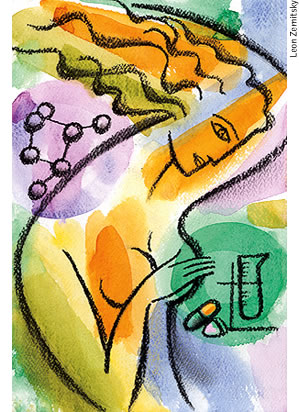 Across
the United States only about 6 percent of breast cancer
patients
are diagnosed with
locally advanced
breast cancer—about 13,000 women a year. But
it is the most common breast cancer diagnosis in
many places outside the United States. Across
the United States only about 6 percent of breast cancer
patients
are diagnosed with
locally advanced
breast cancer—about 13,000 women a year. But
it is the most common breast cancer diagnosis in
many places outside the United States.
It also accounts for nearly one in four
breast cancer patients at Jackson Memorial Hospital.
“My research career started because there was a clinical
problem that I didn’t know how to solve, so I set
about trying to solve it,” says Judith Hurley,
M.D., associate professor of clinical medicine at the
Miller School of Medicine. “I happened to be in
the right place at the right time.”
As early as 1990, Hurley began using platinum-based
chemotherapy—which
was in use to combat other cancers—to treat breast
cancer patients. More recently she has added Herceptin,
which is highly effective against a certain subset of
breast tumors: those that have a human epidermal growth
factor receptor 2, or are “HER2 positive.” Her
latest study involved 48 patients and earned an early-release
publication in the April Journal of Clinical Oncology.
The five-year, disease-free survival rate
for patients with stage III locally advanced breast cancer
is between
20 and 50 percent. But Hurley’s patients had an
85 percent survival rate at 43 months. “Seven relapsed,
but 41 did not,” says Hurley. “Considering
these tumors were an average of 9 centimeters (3 inches)
and HER2 over-expressing, you would expect at four years
that most of the patients would have relapsed.” The
largest tumor in Hurley’s study was 35 centimeters—more
than 13 inches.
Dennis Slamon, M.D., Ph.D., chief of the
UCLA Oncology Center and the creator of Herceptin, worked
with Hurley
on the study. Each patient underwent three stages of
therapy: a 12-week chemotherapy regimen of docetaxel,
cisplatin, and Herceptin to shrink the tumor; surgery
to remove the remaining tumor; and then a 12-week chemotherapy
regimen of adriamycin and cyclophosphamide.
“These patients do very well, almost as well as patients
who had small tumors from the beginning,” says
Eli Avisar, M.D., F.A.C.S., assistant professor of surgery
and co-leader of the Breast Cancer Disease Group at the
University of Miami Sylvester Comprehensive Cancer Center. “The
other thing is that if the tumor shrinks significantly,
that makes surgery easier and sometimes opens the possibility
of sparing the breast and removing only the tumor.”
In fact, one-fourth of the patients had
a complete pathological response. They were cured by
the chemotherapy.
|